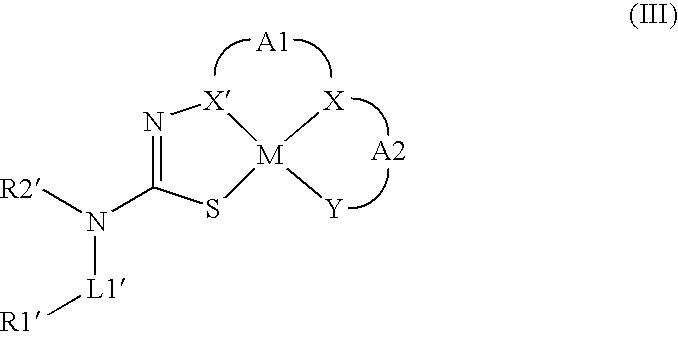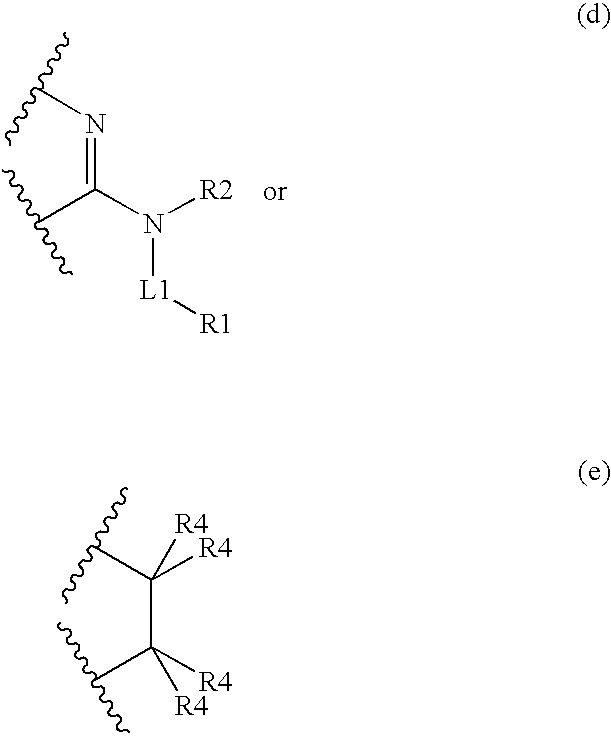Compounds for Imaging and Therapy
a technology of thiosemicarbazone and compound, applied in the field of compound for imaging and therapy, can solve the problems of limited system to technology, system is not suitable for use, and significant loss of radionuclide from chelate, and achieve optimal positioning of the electron donor group
- Summary
- Abstract
- Description
- Claims
- Application Information
AI Technical Summary
Benefits of technology
Problems solved by technology
Method used
Image
Examples
example 1a
L1H2
[0288]Acetyl-N4-methyl thiosemicarbazone (1.540 g, 8.90 mmol) was added to 2-hydrazinopyridine (1.261 g, 11.57 mmol) in ethanol (20 mL). The mixture was heated at reflux under an atmosphere of nitrogen for 3 hours. A beige solid precipitated which was collected by filtration, washed with ethanol and diethyl ether to give L1H2 (1.899 g, 7.18 mmol, 81%). (Found: C, 49.8; H, 6.22; N, 31.7; Calc'd for C11H16N6S: C, 50.0; H, 6.1; N, 31.8). 1H NMR (300 MHz): δ 2.21, 6H, s, 2×CH3; 3.01, d, 3JHH=6 Hz, NH—CH3; 6.83, 1H, m, ArH; 7.23, 1H, d, 3JHH=9 Hz, ArH; 7.69, 1H, m, ArH; 8.18, 1H, m, ArH; 8.33, br s, NH; 9.91, 1H, br s, NH; 10.18, 1H, br s, NH. MS: m / z, 265=[L1+H+]+.
example 1b
[Cu(L1)]
[0289]L1H2 (0.490 g, 1.86 mmol) and copper acetate monohydrate (0.409 g, 2.05 mmol) were added to ethanol. The mixture was heated at reflux under an atmosphere of nitrogen for 3 hours. The purple mixture was allowed to cool to room temperature and a purple solid was collected by filtration and washed with ethanol and diethyl ether to give [Cu(L1)].H2O (0.589 g, 1.71 mmol, 92%). (Found: C, 38.8; H, 4.5; N, 23.8; Calc'd for [Cu(C11H14N6S)].H2O: C, 38.4; H, 4.7; N, 24.4). MS: m / z=326=[Cu(L1)+H+].
example 1c
[Cu(L1H2)](ClO4)2
[0290][Cu(L1)].H2O (ca. 10 mg) was dissolved in methanol (0.5 mL) to give a purple solution. A few drops of concentrated perchloric acid were added (CAUTION! This was done behind a blast shield) causing the solution to immediately turn bright green. Evaporation of the solvent at ambient temperatures gave bright green crystals suitable for X-ray analysis which proved to be [Cu(L1H2)](ClO4)2.
PUM
| Property | Measurement | Unit |
|---|---|---|
| Volume | aaaaa | aaaaa |
| Volume | aaaaa | aaaaa |
| Volume | aaaaa | aaaaa |
Abstract
Description
Claims
Application Information
 Login to View More
Login to View More - R&D
- Intellectual Property
- Life Sciences
- Materials
- Tech Scout
- Unparalleled Data Quality
- Higher Quality Content
- 60% Fewer Hallucinations
Browse by: Latest US Patents, China's latest patents, Technical Efficacy Thesaurus, Application Domain, Technology Topic, Popular Technical Reports.
© 2025 PatSnap. All rights reserved.Legal|Privacy policy|Modern Slavery Act Transparency Statement|Sitemap|About US| Contact US: help@patsnap.com



